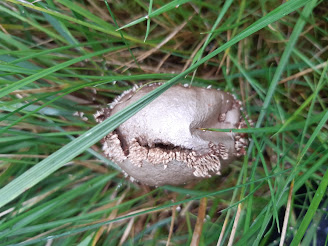Walking through a bracken maze on the hills above Ullswater, I was relieved to spy a stream and the promise of a way out. The bracken thinned as I approached, and gave way to long grass underneath my feet. Something metallic looking in the grass caught my eye. It looked foreign in the environment, and my first thought, when I clocked it's rounded, slightly flattened shape, was that it was a child's purse that had been dropped. Closer inspection revealed that the coppery-coloured mass was not rigid but soft and easily dented, and the projections that I had taken to be jewels were, infact, spines. When I pressed it, it let out a jet of darkly coloured spores from the underside. I knew what it was; a puffball.
I did not immediately recognise it as a spiny puffball, because as you can see from the photo, most of the spines are missing! However, this is something that happens with age, and this puffball was certainly mature enough to puff.
The genus Lycoperdon means 'Wolf's fart', but I can't attest to it's smell, or that of a wolf's to be fair! Echinatum means prickly in Latin. Maybe it does resemble a sea-urchin when it is younger and covered in spines. It tends to grow in alkaline conditions and beech woods, and is a rare find in the UK!






